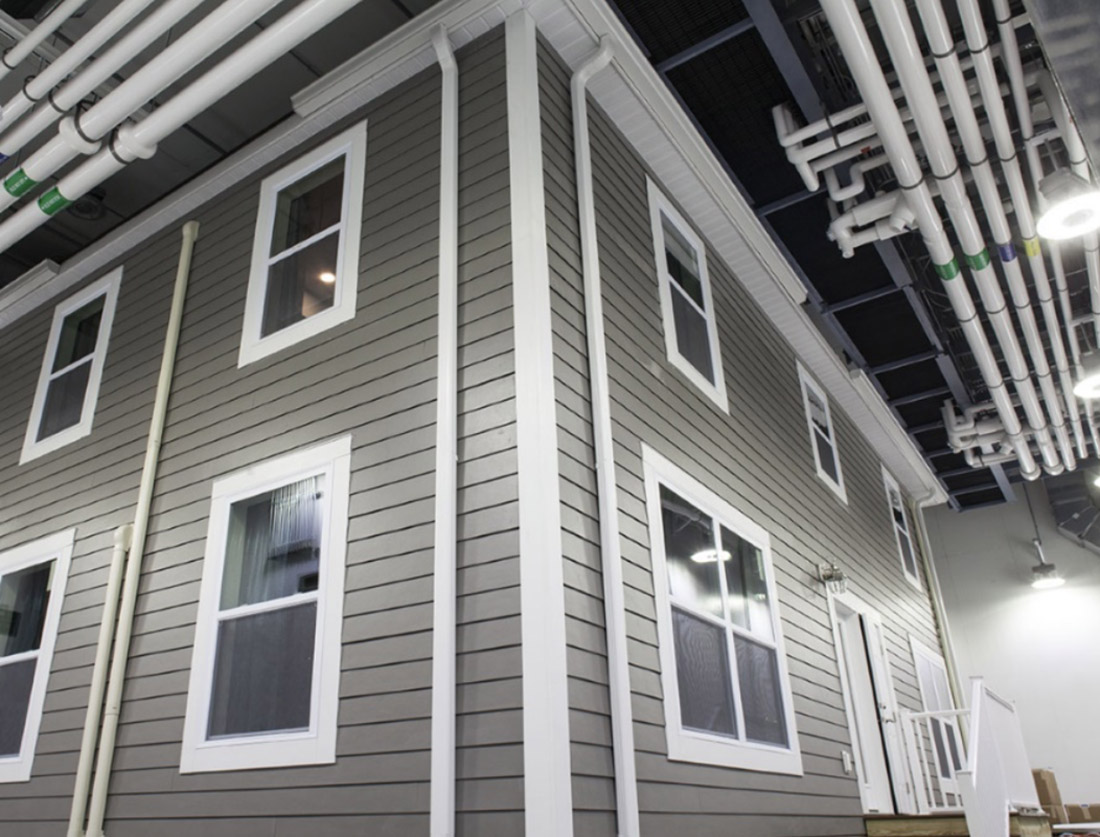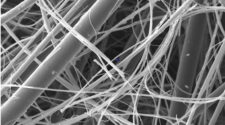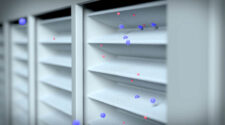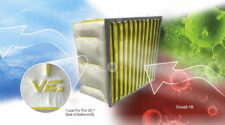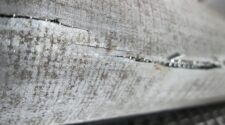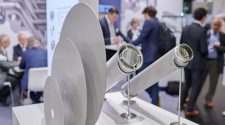As the COVID-19 pandemic has spread and made its impact worldwide, air filtration has risen to prominence as a potential solution to the spread of viral contagions, as well as in addressing air pollution in general. In the United States, high-efficiency HVAC filters and RAPs (room air purifiers) are widely used for mitigating indoor particulate matter and combating the pandemic. However, some critical questions still need to be answered. How efficient are HVAC filters at capturing virus particles? How effective are HVAC filters and RAPs at reducing indoor particulate matter? What is the energy impact of high efficiency HVAC filters? Researchers from 3M, Emerson and LMS Technologies have recently collaborated in a series of scientific studies to answer these critical questions. Their research results will be published in series of articles in International Filtration News. The following article is Part II in this series. Find Part I in this series here. Find Part III in this series here.
A comprehensive study was conducted to understand: (1) the relationship between filter efficiency and CADR (clean air delivery rate) and reduction of the PM (particulate matter) concentration in a house with a forced-air residential HVAC (Heating Ventilation air-Conditioning and Refrigeration) system; and (2) the interaction between the event room, where the PM is generated, and other rooms based on different filters and RAP (room air purifier) configurations. The study was conducted at the Emerson Helix Innovation Center in Dayton, Ohio, using its one-of-a-kind 2,000 square foot, fully functional Residential Home. The home is housed inside an environmental chamber, enabling accurate simulation of diverse indoor and outdoor climate conditions where experiments can be conducted with an unprecedented level of precision and consistency, at a speed unachievable in a real-world setting.
This study concluded that: (1) particles can travel from the particle source space to other rooms within minutes, even with the house fan being turned off; (2) fiberglass filters showed insignificant impact on reducing PM concentration in the house, whereas high efficiency Filtrete HVAC filters demonstrated excellent performance at reducing the PM concentration in the house; (3) the Filtrete RAP was very effective at reducing the PM concentration in a room of use; and (4) the combination of high efficiency Filtrete filters and Filtrete room air purifiers not only provided even faster PM removal in the room of RAP use and also faster PM reduction in other rooms.
Background
Severe air pollution has attracted high levels of public attention, especially recently in both extreme air pollution regions such as China and India and areas with air quality events such as wildfires. As the awareness of air pollution increases, people want better filtration products to improve the air quality in their homes. In the United States and many other countries, indoor air quality (IAQ) has become a major public concern.
Scientific studies[1] revealed that indoor pollutants such as secondhand smoke, combustion pollutants, molds and pet dander have significant negative impact on public health. In recent years, high efficiency filters are used more and more widely in residential HVAC (heating ventilation and air-conditioning) systems as a major means for improving indoor air quality of residential homes.
Zhao et al[2] used a numerical modeling approached to evaluate 11 classifications of filters (MERV 5 through HEPA) and found that use of higher efficiency filters would reduce premature mortality by 0.002–2.5% and increase life expectancy by 0.02–1.6 months.
Wallace et al.[3] also used a modeling approach to investigate HVAC filtration. They calculated the deposition rates of particles in an occupied house due to forced-air circulation and the use of in-duct filters such as electrostatic precipitators (ESP) and fibrous mechanical filters (MECH). Deposition rates are calculated for 128 size categories ranging from 0.01 to 2.5 µm. They found that the whole house filtration by HVAC filters or ESP (electrostatic precipitator) was more effective than the alternative approach of reducing ventilation by closing windows or insulating homes more tightly.
Parham Azimi and Brent Stephens[4] applied a methodology for estimating the impact of recirculating heating, ventilating, and air-conditioning (HVAC) particle filters on the control of size-resolved infectious aerosols in indoor environments using a modified version of the Wells-Riley model. Overall, recirculating HVAC filtration was predicted to achieve risk reductions at lower costs of operation than equivalent levels of outdoor air ventilation, particularly for MERV 13 – 16 filters.
Brown et al[5] found that use of a MERV12 or higher performing air filter in home ventilation systems can effectively reduce indoor levels of these common asthma and allergy triggers. These reductions in airborne allergens in turn may help reduce allergy and asthma symptoms, especially if employed in conjunction with other environmental management measures recommended for allergy and asthma patients.
Elvira et al.[6] studied the effectiveness of room air purifiers. A total of 21 nonsmoking couples participated in a randomized, double-blind, crossover study with two consecutive 48-hour exposures to either particle-filtered or nonfiltered air in their homes. They concluded that reduction of particle exposure by room air purifiers for only 48 hours improved MVF (microvascular function) in healthy elderly citizens, suggesting that this may be a feasible way of reducing the risk of cardiovascular disease.
Xu et al.[7] conducted a study to assess whether operating a room air purifier in a child’s bedroom can improve his/her respiratory health. The results indicate that air cleaning in combination with ventilation can effectively reduce symptoms for asthma sufferers.
However, previous studies were mostly based on theoretical modeling of HVAC filtration. Limited experimental studies were conducted with many compounding factors, making it difficult to draw a clear conclusion on the impact of HVAC filters and room air purifiers on the indoor air quality. More importantly, it is imperative in the current COVID pandemic to understand how particulates, such as virus carrying particles, generated in one room travel and redistribute in various spaces of the house, as well as the impact of the HVAC filtration or the room air purifier on air quality. In addition, the effectiveness of the combination of HVAC filters and room air purifiers in mitigating indoor PM concentration was not well understood.
In this study, we evaluated the effectiveness of HVAC filters and room air purifiers in three conditions: (1) only HVAC filtration was used in the house; (2) only room air purifier was used in a room; (3) HVAC filtration was used for the whole house while the room air purifier was used in a room.
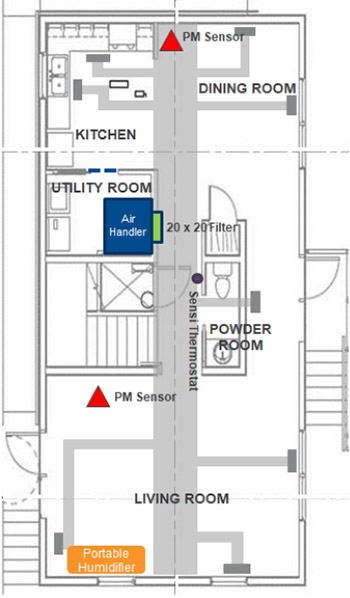
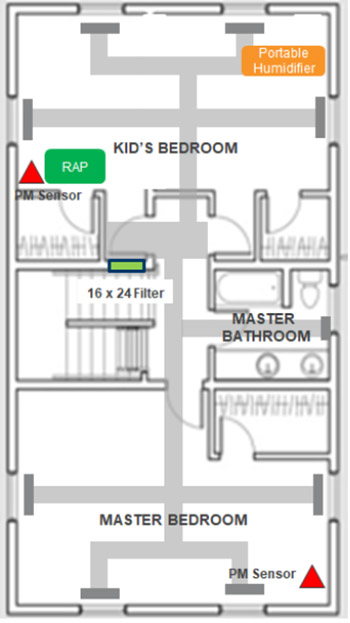
System Description
The Emerson Helix Innovation Center is a 40,000-square-foot facility located on the University of Dayton campus in Dayton, Ohio, focused on providing a collaborative environment for researchers, academia, and industry professionals to develop solutions to industry challenges. The facility is uniquely suited to enable cutting edge testing in simulated real-world environments. To allow for accurate and repeatable testing of filter impacts on indoor air quality in a real-world setting, testing was conducted in the Helix Home Module.
The Helix Home Module is comprised of a fully furnished and fully operational 2000 square foot, two story residential home, housed within a sealed environmental chamber (Figure 1). This setup allows researchers to control outdoor ambient conditions with temperatures ranging from -20°F to 120°F and humidity from 20%RH to 90%RH.
The home is also outfitted with lighting, electronics, appliances, and plumbing, all representative of a similarly sized residential home.
The indoor portion of the home’s HVAC system contains a Carrier FX4DNF037L00ACA furnace, which contains a variable speed Endura 1/2hp FM19 ECM blower motor. For this study, the cooling/heating function was disabled in order to prevent interruption of the tests, only the blower motor was permitted to turn on and off when required. The indoor system is ducted in a downflow configuration with two air return vents, one on the first floor and one on the second floor. These return vents are where the filters are located within the Helix home.
To track PM levels in different zones of the home, PM sensors were placed in the kitchen, living room, master bedroom and kids’ bedroom and this data was collected using the home’s dedicated data acquisition system.
Testing Method
Testing in the home was performed with 3 different configurations
- PM exposure in an open space of the house, followed by PM mitigation with the whole house HVAC filtration, i.e. the blower motor + HVAC filters
- PM exposure in a single room, followed by PM mitigation with a room air purifier
- PM exposures in an open space of the house and a single room, followed by PM mitigation with the whole house HVAC filtration and a room air purifier in the single room
PM exposures/events were created in the home by using portable ultrasonic humidifiers filled with tap water, which when operated in this manner create a consistent, high level of PM2.5 when the mineral deposits in the tap water droplets remain as solid particles after the water has evaporated. Operation of the portable humidifiers and the whole home blower motor were both controlled automatically, using the PM2.5 sensor readings in the room for control, so that the tests could be run as consistently as possible. The RAP was controlled manually. The general location of the portable humidifiers, PM sensors, HVAC filters and room air purifier are shown in Figures 4 and 5.
Table 1 represents the matrix of tests which were conducted in the home under the 3 different test configurations. Regarding test configuration 1, which was used for tests 1-7, here is the testing procedure:
- With the whole home blower motor off, turn on the portable humidifiers in the living room and kids’ bedroom.
- Kids’ bedroom door should be open
- Once PM sensors in the kitchen and kids’ bedroom exceed a reading 80 µg/m3, turn off both portable humidifiers and turn on whole home blower motor on high speed.
- Run test until the kitchen and kids’ bedroom PM sensor values fall below 10 µg/m3.
For test configuration 2, which was used for tests 8-13, the testing procedure used was:
- With the whole home blower motor off, turn on the portable humidifier in the kids’ bedroom.
- Kids’ bedroom door should be closed
- Once PM sensor in kids’ bedroom exceeds a reading 80 µg/m3, turn off the portable humidifier
- Turn on air purifier to fan speed called for in test matrix (low speed = 1, high speed = 4)
- Run test until the kids’ bedroom PM sensor reading falls below 10 µg/m3.
For test configuration 3, which was used for tests 14-25, the testing procedure used was:
- With the whole home blower motor off, turn on the portable humidifiers in the living room and kids’ bedroom.
- Kids’ bedroom door should be closed.
- Once PM sensors in the kitchen and kids’ bedroom exceed a reading 80 µg/m3, turn off both portable humidifiers and turn on whole home blower motor on high speed.
- Turn on air purifier to the fan speed called for in test matrix (low speed = 1, high speed = 4)
- Run test until the kitchen and kids’ bedroom PM sensor values fall below 10 µg/m3.
Descriptions of Filters and The Room Air Purifier
Three types of HVAC filters were selected for this study to represent typical low, medium and high efficiency filters used in residential homes. The first type of filters were fiberglass filters, selected as a baseline to represent low efficiency filters. The second type of filters were Filtrete MPR 800 filters, representing medium efficiency filters. The third type of filter were Filtrete MPR 2800 filters, representing high efficiency filters. The Emerson Helix Home Module has two return air filter inlets: a 14 in (width) x 24 in (length) x 1 in (depth) inlet and a 20 in x 20 in x 1 in inlet. In this study, filters of two different sizes: 14 x 24 and 20 x 20, were used. For each filter size, two filter samples were tested. The properties and characteristics of test filters are shown in Table 2. Filtrete MPR 800 and MPR 2800 filters are both made of electrostatically charged filtration media. Please note that the pressure drop shown in Table 2 was measured at 295 FPM per ASHRAE 52.2 test standard, i.e. the differential pressure across a filter at the described air face velocity. Properties of the RAP unit is shown in Table 3.
Results and Analysis
(a) Configuration 1: Whole Home-HVAC Filer Study
To study the effectiveness of HVAC filtration on the indoor air quality, three different types of filters were tested: fiberglass, Filtrete MPR 800, and Filtrete MPR 2800 filters.
Figures 3 shows examples of how PM concentrations varied in the house before and after the PM exposure was shut off. In the PM exposure period, i.e. when the humidifiers were turned on and the whole house fan was shut off, PM concentrations in the PM exposure spaces, e.g. the living room and kids’ bedroom, quickly increased, while in non-PM exposure spaces, e.g. kitchen and master bedroom, the PM concentrations also increased with some delay. This indicates that even without forced air movement, particles can travel from the source space to other spaces by diffusion or other air movement mechanisms such as natural convection or turbulence. This finding has important practical values. For example, it implies that virus particles generated in one room, can travel to other rooms within minutes, even the whole house fan was shut off.
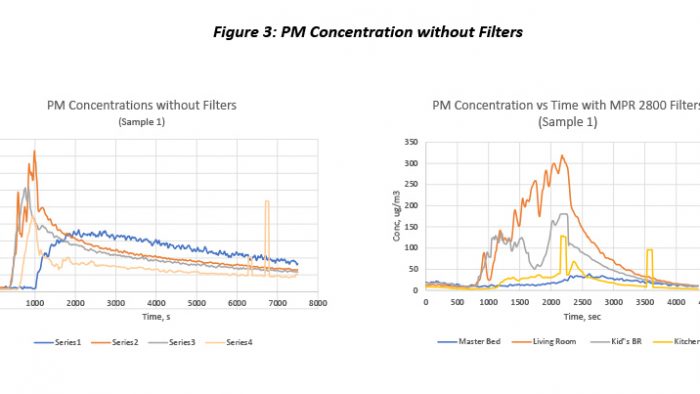
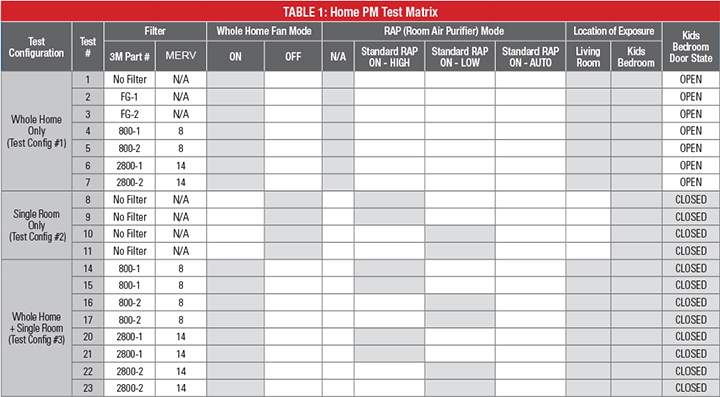


After the humidifiers were turned off and the HVAC fan turned on, PM concentrations in the living room and kids’ room immediately decreased sharply due to mixing with cleaner air from other rooms, then continuously decreased with different rates, depending on the filtration level of the filters. Although humidifiers should be stopped once the PM concentrations in the kitchen or kids’ bedroom exceeded 80 mg/m3, there was some delay in PM concentration responses in different locations. Therefore, in some cases, the PM concentration exceeded 80 mg/m3. It was observed that PM concentration curves of the kitchen showed some abnormal spikes, i.e. step increases and step decreases, which can be attributed to the occasional malfunction of the PM sensor in that room.
To analyze the effectiveness of different filtration systems, the normalized PM concentrations in different rooms were calculated and plotted in Figures 4-7. The normalized PM concentration is defined as follows:
The peak PM concentration is the PM concentration immediately after the humidifiers were turned off.
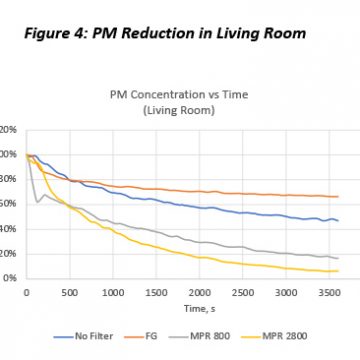
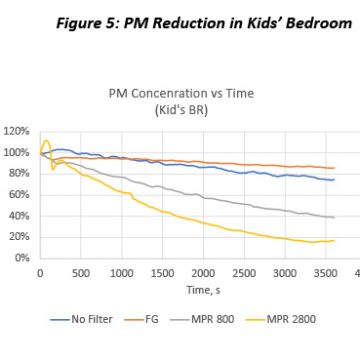
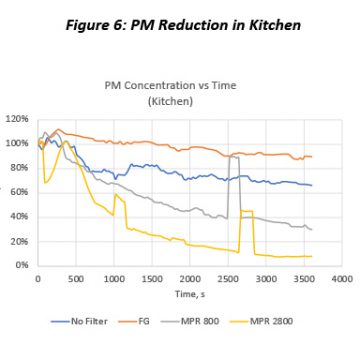
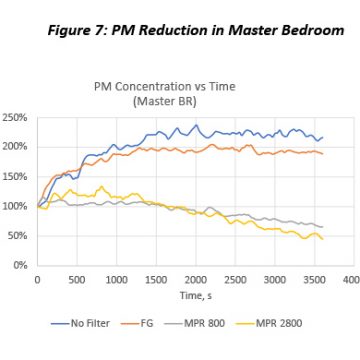
Negative values in the table means that the PM concentration was higher than the “peak” concentration, which was the PM concentration immediately after the humidifiers were turned off. The impact of filtration efficiency is clearly seen in Figures 4-7 and Table 4. For example, in the Living Room, the PM concentration was reduced by 94% within 60 minutes with the MPR 2800 filters, while the PM concentration only decreased by 34% with fiberglass filters during the same time. It is also interesting to see that when fiberglass filters were used, the master bedroom PM concentration increased by 89% even after 60 minutes of HVAC operation. The increase of PM concentration can be attribute to the fact that dirty air from the living room and kids’ room was circulated into the master bedroom, which also shows ineffectiveness of fiberglass filters. Both the medium and high efficiency filters exhibited a “protective effect” in preventing the concentration in master bedroom from rising when considering the entire one-hour test duration.
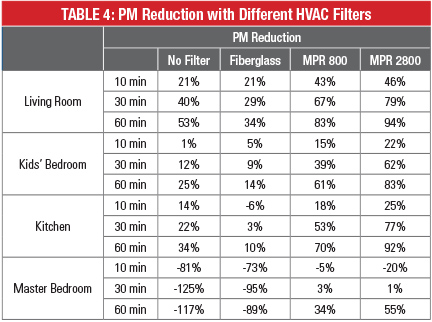
(b) Configuration 2: Single Point-Room Air Purifier Study
This study was carried out to investigate the effectiveness of room air purifiers in a single room. A Filtrete FAP-T02-F1 room air purifier was used in this study. The RAP unit was placed in the kids’ bedroom (general location shown in Figure 3), which has 288 ft2 floor area. For each test, the room door was closed and whole house fan was turn off. A humidifier filled with tap water was used to generate PM exposure. Once the PM concentration reached 80 mg/m3, the humidifier was turned off and the RAP unit was turned on and set at the specified speed setting throughout the test. After the RAP was turned on, the PM concentration decay was recorded for one hour. Figure 8 shows a typical PM concentration curves once the RAP was turned on.
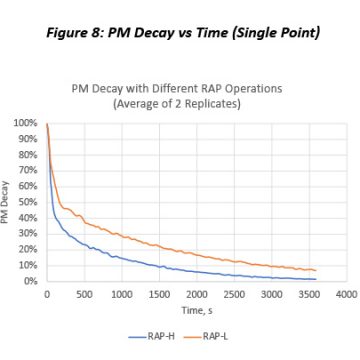
(1)Average of two replicates
As seen in Figure 8 and Table 5, Filtrete Room Air Purifier units delivered excellent PM reduction performance. Filtrete model FAP-T02-F1 at High setting achieved 99% PM reduction with one-hour continuous operation, while the Filtrete FAP-T02-F1 at Low setting achieved 93% PM reduction within one hour.
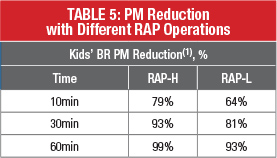
(c) Configuration 3: Whole Home + Single Point Study (HVAC Filter + RAP Study)
This study was carried out to investigate the combined effects of HVAC filters and a room air purifier in different spaces of the house. A room air purifier: a Filtrete FAP-T02-F1, as well as Filtrete MPR 800 and 2800 HVAC filters were used in this study. The RAP unit was placed in the kids’ bedroom. In this study, the kids’ bedroom door was closed and whole house fan was turn on. Filtrete FAP-T02-F1 was operated at two settings: High speed and Low speed. Humidifiers filled with tap water were used to generate PM exposure in the living room and the kids’ bedroom with the door closed. Once the PM concentration in the kitchen and kids bedroom reached 80 mg/m3, 1) the humidifiers were turned off, 2) the RAP unit was turned on and set at the specified speed setting throughout the test, and 3) the whole home fan was turned on. The PM concentration decay was recorded from the start of the test and for one hour after the RAP and whole home fan were turned on. The PM concentrations as a function of time with MPR 2800/RAP combinations are shown in Figure 9 as examples.
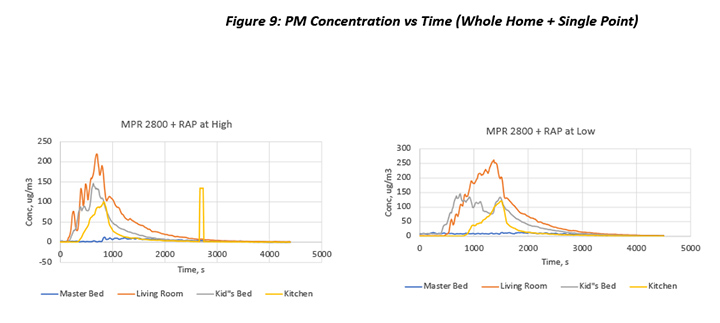
The PM concentrations in various rooms decreased due to filtration by HVAC filters and the operation of the RAP unit. To understand the PM reduction in different conditions, the normalized PM concentration decay from the peak point was shown in Figure 10 for various test conditions.
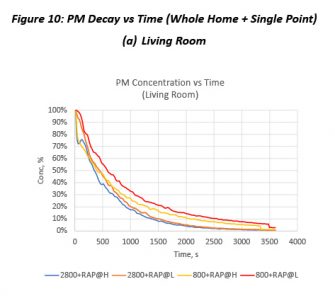
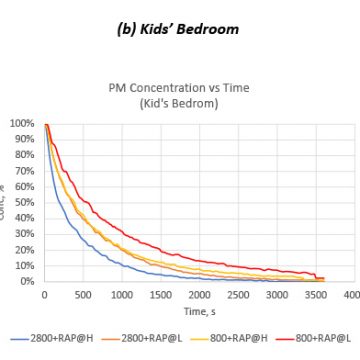
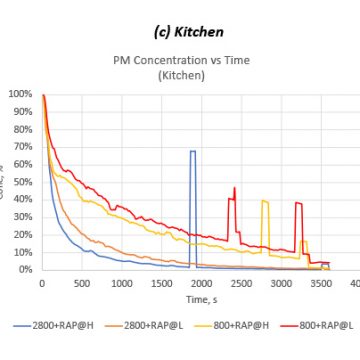
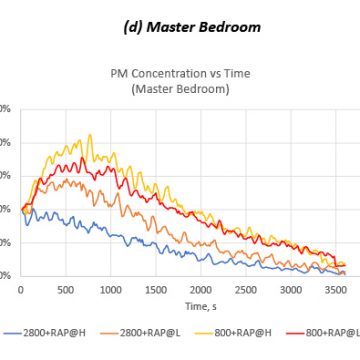
Figure 10 (a)-(d) clearly show the impact of the filtration efficiency on the PM reduction. First, the PM reduction rates are significantly higher with the MPR 2800 filter (MERV 14) as compared to the PM reduction with MPR 800 (MERV 8) filters. Secondly, PM decay curves showed very different patterns. With MPR 800 filters, the PM concentration in the master bedroom, where the ventilation was less effective, first increased after the humidifier was turned off and the house fan was turned on, then gradually decreased with time. In comparison, with MPR 2800 filters, the PM concentration in the master bedroom immediately decreased after the PM exposure was turned off and the whole house fan was turned, and continued the decreasing trend. Figure 10 (c) shows some abnormalities, due to occasional abnormal function of the PM sensor in the kitchen.
Table 6 shows the numerical values of the PM reduction in different rooms at 10 minutes, 30 minutes and 60 minutes of the HVAC system and RAP operation. It is obvious to see advantage of the high efficiency HVAC filter (MPR 2800) over the medium efficiency filter (MPR 800).
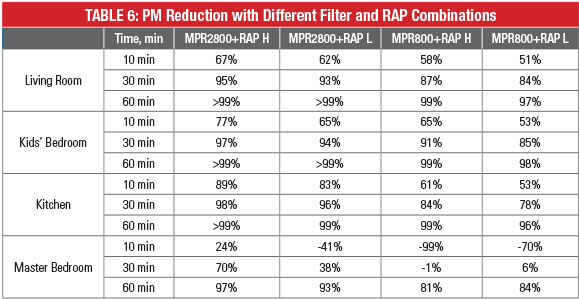
To better understand the impact of Filtrete room air purifier on the whole house PM reduction, PM reductions with Filtrete MPR 800 and MPR 2800 filters and with the combination of Filtrete HVAC filters and RAP are shown in Table 7. It is clearly seen that Filtrete room air purifiers not only effectively reduced particle concentration in a single room, but also significantly improved PM reduction in other spaces of the house. In other words, combination of Filtrete HVAC filters and Filtrete room air purifiers delivered the most effective PM reduction in the whole house.

Conclusions
This study revealed several important facts of the particle transport in a house and impacts HVAC filtration and RAP filtration on the indoor air quality. Firstly, the experimental results showed that particles can travel from the particle source space to other rooms within minutes even with the whole house fan turned off. Secondly, while fiberglass filters showed insignificant impact on removing particulate matters in the house, high efficiency Filtrete HVAC filters, such as MPR 2800 filters, demonstrated excellent performance at reducing the PM concentration in all spaces of the house. The medium efficiency filters, e.g. MPR 800 filter, also delivered fairly effective PM reduction in most spaces of the house. Thirdly, Filtrete RAP unit was very effective at reducing the PM concentration in the room where it operated. Lastly, the combination of high efficiency Filtrete filters and a Filtrete RAP not only provided significant PM removal in a single room, but they also allowed faster PM reduction in other rooms.
References
- EPA 402/F-08/008 | September 2008.
- Dan Zhao, Parham Azimi † and Brent Stephens, “Evaluating the Long-Term Health and Economic Impacts of Central Residential Air Filtration for Reducing Premature Mortality Associated with Indoor Fine Particulate Matter (PM2.5) of Outdoor Origin,” Int. J. Environ. Res. Public Health. 2015, 12, 8448-8479; doi:10.3390/ijerph120708448.
- Lance A. Wallace, Steven J. Emmerich, Cynthia Howard-Reed, “Effect of central fans and in-duct filters on deposition rates of ultrafine and fine particles in an occupied townhouse,” Atmospheric Environment, 38 (2004) 405–413.
- Parham Azimi, Brent Stephens, “HVAC filtration for controlling infectious airborne disease transmission in indoor environments: Predicting risk reductions and operational costs,” Building and Environment, Volume 70, December 2013, 150-160.
- Kathleen Ward Brown, ScD1 , Taeko Minegishi, MS1, Joseph G. Allen, DSc1,2, John F. McCarthy, ScD1, John D. Spengler, PhD2, and David L. MacIntosh, ScD1,2, “Reducing patients’ exposures to asthma and allergy triggers in their homes: an evaluation of effectiveness of grades of forced air ventilation filters,” J Asthma, 2014; 51(6): 585–594.
- Elvira Vaclavik Bra¨uner1, Lykke Forchhammer, Peter Møller, Lars Barregard, Lars Gunnarsen, Alireza Afshari, Peter Wahlin, Marianne Glasius, Lars Ove Dragsted, Samar Basu, Ole Raaschou-Nielsen, and Steffen Loft, “Indoor Particles Affect Vascular Function in the Aged-An Air Filtration–based Intervention Study,” American Journal of Respiratory and Critical Care Medicine, Vol 177 2008, p 419.
- Ying Xu, Suresh Raja, Andrea R. Ferro, Peter A. Jaques, Philip K. Hopke, Cheryl Gressani, Larry E. Wetzel, “Effectiveness of heating, ventilation and air conditioning system with HEPA filter unit on indoor air quality and asthmatic children’s health,” Building and Environment, 45 (2010) 330–337.


